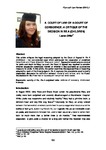A Court of Law or a Court of Conscience: A Critique of the Decision in Re A (Children)
| dc.contributor.author | Offer, Laura | |
| dc.date.accessioned | 2017-03-28T14:14:33Z | |
| dc.date.accessioned | 2017-04-11T11:20:25Z | |
| dc.date.available | 2017-03-28T14:14:33Z | |
| dc.date.available | 2017-04-11T11:20:25Z | |
| dc.date.issued | 2012 | |
| dc.identifier.citation |
Offer, L. (2012) 'A Court of Law or a Court of Conscience: A Critique of the Decision in Re A (Children)', Plymouth Law and Criminal Justice Review, 4, pp. 132-151. Available at: https://pearl.plymouth.ac.uk/handle/10026.1/8965 | en_US |
| dc.identifier.issn | 2054-149X | |
| dc.identifier.uri | http://hdl.handle.net/10026.1/8965 | |
| dc.description.abstract |
This article critiques the legal reasoning adopted by the Court of Appeal in Re A (Children) – the controversial case which addressed the separation of conjoined twins Rose and Grace Attard (or 'Mary and Jodie'). Separation would ensure survival for Jodie and death for Mary; as such, the Court of Appeal was required to consider whether separation constituted murder or whether it was justifiable as a protective measure for Jodie. In this article, the author examines the separate lines of reasoning adopted by each of the three judges in Re A, explores the precedents used to justify separation, discusses the distinction between 'morality' and 'ethics', and the impact the decision in Re A has had on subsequent 'conjoined twins' cases. | en_US |
| dc.language.iso | en | en_US |
| dc.publisher | University of Plymouth | |
| dc.rights | Attribution 4.0 International (CC BY 4.0) | * |
| dc.rights.uri | https://creativecommons.org/licenses/by/4.0/ | * |
| dc.subject | sanctity of life | en_US |
| dc.subject | Re A conjoined twins | en_US |
| dc.subject | defence of necessity | en_US |
| dc.subject | child's best interests | en_US |
| dc.title | A Court of Law or a Court of Conscience: A Critique of the Decision in Re A (Children) | en_US |
| dc.type | Article | en_US |
| dc.type | Article | |
| plymouth.volume | 4 | |
| plymouth.journal | The Plymouth Law & Criminal Justice Review |



